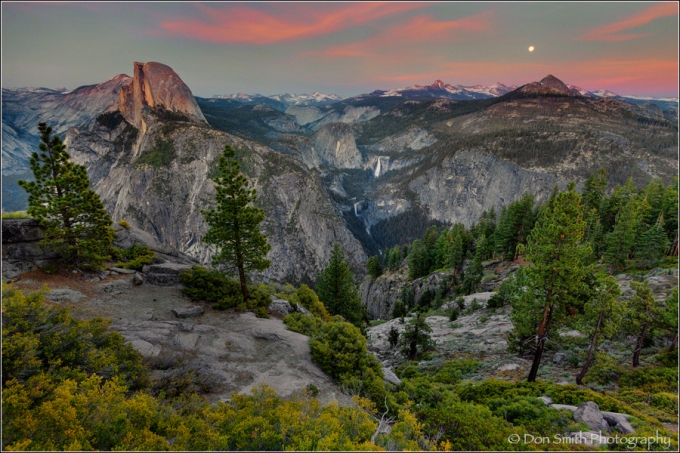Nature's Best :: Don Smith Photography
Exploring our incredible world one image at a time!
The Power Of Adding A Moon To Your Image
Posted on May 16, 2014

Moonrise Over Yosemite High Country, Ansel Adams Wilderness, Yosemite National Park
Canon 5DMKIII, 18mm, f/11, 2.5 seconds, ISO 100, Singh-Ray Thin LB Polarizer, Singh-Ray 2 stop, hard edge GND, Lexar Digital Media
If you have been following my posts for any length of time, then you know how important moon images are to me. They are so important in fact, that I plan many of my workshops around the full moon.
I captured this image Wednesday evening from Yosemite’s Glacier Point looking east over the Ansel Adams Wilderness just after sunset. I was co-teaching Gary Hart’s Spring Yosemite Workshop. We had the group at Glacier for a sunset shoot the evening prior.
Gary went around to all the participants and said he was going back to the Geological Exhibit Hut area to photograph the rising moon. About half the group chose to go while the other half stayed to shoot the setting sun. Gary asked if I would stay with that group.
The next day at image review, Gary showed his image and an audible sigh went up from those of us who missed the moonrise (we could not include it with Half Dome from our position). Within ten minutes, the group had voted to go back to Glacier that evening to try again.
One cool thing about the moon is that it rises, on average, about 50-60 minutes later each evening. The full moon always rises near sunset (usually, but not always, the day before the actual full moon). Gary calculated via topo software and a software program that on this particular evening, the moon would start rising to the left of Mt. Starr King about 30 minutes prior to sunset. His calculations were right on the mark. By the time I captured this image, it was 3 minutes past posted sunset. This allowed me to make the capture with only the aid of a Singh-Ray 2 stop GND so I did not lose detail in the moon; albeit very small in this image.
So why am I so moon crazy? I feel there is such an emotional draw to the moon – especially in wilderness settings. I photograph either full or crescent moons. Quarters and half moons tend not to hold as much appeal for me.
One cool thing about the moon is that it rises, on average, about 50-60 minutes later each evening. The full moon always rises near sunset (usually, but not always, the day before the actual full moon).
The other benefit of including a moon, even a small one such as this moon due to an extreme wide angle lens, is that they hold a tremendous amount of visual weight. Visual weight is not physical weight; rather, it acts as visual element that tends to keep the image in balance. Imagine this image sitting on a fulcrum point. Half Dome weighs the left side of the frame, Starr King (the peak below the moon) does act as a bit of a counter-balance for the scene, but the tiny moon completes the balance.
Including Half Dome in this frame with the moon dictated that I photograph it wide. I had this scene composed just as the moon started rising, but did not like my initial location because the foreground was bare on the left side.
I moved around until I found this scene with Half Dome framed by these two pines. I also liked that Nevada and Vernal Fall were now moved to the center of the composition. I climbed atop a boulder to include some of the foreground foliage as it was darker in tone and would hold the bottom of the frame better than just light-toned granite.
I used my 16-35mm Canon Series II lens at 18mm. Because I was so wide, I opted for an aperture of f/11 as I knew the lens would be near its sharpest in rendering the image. After that, it was just a matter of being patient and waiting for the dusk hues to arrive and add some color to the bands of cirrus clouds that were hanging around the Sierra crest.
NOTE: Due to the extreme wide angle, there is a bit of parallax distortion. I chose not to correct this as it dramatically cropped this image and changed the entire feel.
The most vibrant color arrived three minutes after sunset (something I was prepared for having witnessed this scene the evening before in similar conditions).
Everyone in the group seemed to have success. That means 13 more images similar to this one now exist, but only one other participant had the same foreground as me as he accepted my invitation to join me on the boulder.
Moon photography is not hard. There are many apps and software available to help you plan your own moon shoot. Perhaps the most popular is the Photographer’s Ephemeris and another is Photo Pills (for tablets and smart phones).
Free Video Sample :: Chapter 19 – Introduction to Luminosity Masks
2014 Photo Workshops – Complete List
2015 Photo Workshops
Software Discounts
Photomatix Pro 4.2 type in code at checkout: donsmithphotography 15% discount
Topaz Software type in code at checkout: SMITHPHOTO 10% discount
Category: Landscape Photography Tagged: Ansel Adams Wilderness, dusk, moonrise, Star King, Yosemite National Park
Recent Posts
- Why I Will Never Fly American Airlines Again :: At Least Not After Next Tuesday…
- New Blog Site For Don Smith Photography!
- Do You Look Or Do You See? Developing Your Creative Vision :: Part 2 of 3
- Do You Look Or Do You See? Start With 10,000 Hours Of Practice :: Part 1 of 3
- Photographing Wildflowers In The Wind At Big Sur’s Garrapata State Park
